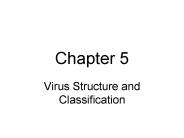VIRUS STRUCTURE - PowerPoint PPT Presentation
1 / 16
Title:
VIRUS STRUCTURE
Description:
Some structures are much more complex than others, and require complex assembly ... Tobacco mosaic virus is typical, well-studied example ... – PowerPoint PPT presentation
Number of Views:1457
Avg rating:3.0/5.0
Title: VIRUS STRUCTURE
1
VIRUS STRUCTURE
- Basic rules of virus architecture, structure, and
assembly are the same for all families - Some structures are much more complex than
others, and require complex assembly and
dissassembly - The capsid (coat) protein is the basic unit of
structure functions that may be fulfilled by the
capsid protein are to - Protect viral nucleic acid
- Interact specifically with the viral nucleic acid
for packaging - Interact with vector for specific transmission
- Interact with host receptors for entry to cell
- Allow for release of nucleic acid upon entry into
new cell - Assist in processes of viral and/or host gene
regulation
2
Nucleoprotein has two basic structure types
- HELICAL Rod shaped, varying widths and specific
architectures no theoretical limit to the amount
of nucleic acid that can be packaged - CUBIC (Icosahedral) Spherical, amount of nucleic
acid that can be packaged is limited by the of
the particle - Virus structure is studied by
- Transmission electron microscopy (EM)
- Cryo EM one of the most powerful methods
currently available - X-Ray diffraction
- Neutron scattering
- Primary sequence analysis
- Protease and footprinting
- Site-directed mutagenesis
3
Principles of basic virus structure
- Nucleoprotein must be stable but dissociatable
- Capsid is held together by non-covalent,
reversible bonds hydrophobic, salt, hydrogen
bonds - Capsid is a polymer of identical subunits
- Terms
- Capsid protein coat
- Structural unit protein subunit
- Nucleocapsid nucleic acid protein
- Virion virus particle
- Capsid proteins are compactly folded proteins
which - Fold only one way, and robustly
- Vary in size, generally 50-350 aa residues
- Have identifiable domains
- Can be described topologically similar
topological features do not imply evolutionary
relationships
4
Helical symmetry
- Tobacco mosaic virus is typical, well-studied
example - Each particle contains only a single molecule of
RNA (6395 nucleotide residues) and 2130 copies of
the coat protein subunit (158 amino acid
residues 17.3 kilodaltons) - 3 nt/subunit
- 16.33 subunits/turn
- 49 subunits/3 turns
- TMV protein subunits nucleic acid will
self-assemble in vitro in an energy-independent
fashion - Self-assembly also occurs in the absence of RNA
TMV rod is 18 nanometers (nm) X 300 nm
5
RNA
Coat protein
TMV
6
Cubic (icosahedral) symmetry
TBSV icosahedron is 35.4 nm in diameter
- Tomato bushy stunt virus is typical, well-studied
example - Each particle contains only a single molecule of
RNA (4800 nt) and 180 copies of the coat protein
subunit (387 aa 41 kd) - Viruses similar to TBSV will self-assemble in
vitro from protein subunits nucleic acid in an
energy-independent fashion
T 3 Lattice
C
N
Protein Subunits
Capsomeres
7
Atomic Resolution Microscope at UC Berkeley The
Atomic Resolution Microscope is specifically
designed for performance in the high resolution
imaging mode with a point-to-point resolution of
1.5Å.
Typical modern transmission EM This JEOL
Transmission Electron Microscope, similar to the
one we use at Rutgers, is housed at Colorado
State University
8
Typical transmission electron micrograph of
negatively stained, purified virus preparation
calicivirus Note that heavy metal stain
penetrates into spaces, resulting in
electron-opaque areas against electron-transparent
protein background in particles
9
Cryo-electron microscopy(excerpted from Norman
Olson, Purdue U.)
- Cryo-EM is TEM in vitreous ice
- Vitreous ice is water frozen to -140 C in less
than 10-4 sec - Vitreous ice state must be maintained in
microscope - Advantages of Cryo-EM
- Preserves native structure of sample
- Reduces electron beam damage
- Allows examination of large, complex
macromolecules - Disadvantages of Cryo-EM
- Technically difficult
- Samples are sensitive to beam damage
- Images have low contrast
10
From N. Olson web site
11
From N. Olson web site
12
From N. Olson web site
13
From N. Olson web site
14
From N. Olson web site
15
From N. Olson web site
16
From N. Olson web site































